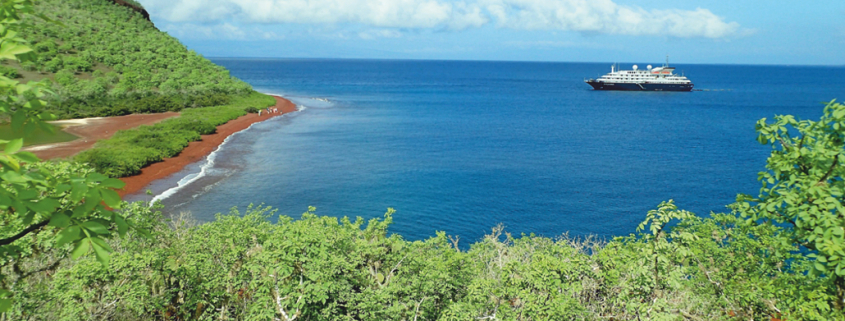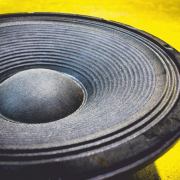Waste at Galapagos: How to Keep the Islands Clean
The Galapagos archipelago is composed of 127 islands, islets and rocks. In 1959, 97 percent of the total emerged surface was appointed National Park. In 2001 the islands were declared a UNESCO World Natural Heritage Site. But in 2018, the German Kreditanstalt für Wiederaufbau described the archipelago as a “paradise in need”: Galapagos is confronted with a growing amount of waste.
According to a WWF paper on “Integrated Solid Waste Management in Island Regions”, since 2006 on Santa Cruz Island, differentiated collection had “almost 100 percent coverage” with a recycling system in place. In fact, until 2009, no technological landfill existed, and the waste was spread at a special location. The first “real” landfill was installed in 2011 at the Santa Cruz Island after a land reclamation. At that time, San Christóbal and Santa Cruz produced about 10-13 tons of waste per day, respectively. That did not include the waste raised by the cruise ships – all in all, about three tons daily – that untreated ended at dumps. A video taken in 2010 merely shows an underdeveloped separation facility consisting of a roofed shelf with several small heaps of recyclables and a huge open-air pile of plastic bottles manually separated by colors without conveyor. “The recyclable waste is separated manually and treated to retrieve the greatest possible amount, while the organic waste is started at the stage of shredding and biostabilization”, an MDPI-article in 2014 explained. The efficiency at that time was estimated at 10 m3/day for recycled material and 1-2 m3/day for treating organic waste.
Classified and categorized?
Galapagos Conservation Trust’s Waste Management Report 2021 mentions that the archipelago was the first province in Ecuador to have a waste management system with “separation at source”. It started in Santa Cruz in 2003, in San Christóbal in 2007 and in Isabela in 2011. WWF reported that between 2003 and 2006, with funding from the European Union, the municipality of Santa Cruz built a “recycling plant” and a “compost area” and purchased a waste compactor truck. Moreover, a system for separating and recycling packaging waste was implemented in Santa Cruz Island until 2010. Allegedly waste was then classified and categorized on material staying in the islands for reuse and materials selected for shipment to the continent. However, students from the Colorado State University reported that in 2016 – although residents actively separating their waste into organic, recyclable, and non-organic color-coded containers – “both recyclables and non-organic waste is currently being dumped into a single unsealed landfill (which is on fire) since the only compacting machine they have is not functioning”.
Cement bags and egg trays
However, in 2012, 125 tons/month of organic waste, 130 tons/month of non-recyclables and 75 tons/month of recyclables are said to be generated and treated in the Fabricio Valverde Recycling Center (PAFV) in Santa Cruz, built with funds from the European Union. The recyclables included cardboard (58 percent), glass (24 percent), plastic (9 percent), paper (6 percent) and cans, Tetra Pak, cement bags, egg trays, and batteries with percentages below one percent. A WWF paper on “Integrated Solid Waste Management in Island Regions” suggests that in 2012 about 50 percent of the overall waste generated on Santa Cruz Island was recycled.
0.85 kg per tourist daily
During the next years, the amount of waste rose. A paper on “Galapagos and the plastic problem” shows a rise from 18.8 tons of waste per day in 2010 to 28.6 tons of waste per day in 2019, “reflecting the growth in tourist numbers and the local population”. While in the late 1960s, the islands received approximately 2,000 visitors per year, the number increased to over 160,000 tourists visiting each year in 2016 and about 300.000 in 2020. Additionally, the tourism model changed from strongly regulated boat tourism to weakly regulated land-based tourism resulting in increasing local waste productions and pressure on collection systems. The economic benefits of the tourism industry also led to a boom in resident population growth from 4,000 in 1970 to over 25,000 in 2016 and slightly over 33,000 in 2020, says Max Martin, director of environment technology firm Orca Tec, in a video lecture. A Veolia study in 2019 projected the daily waste production of a visitor at 0.85 kg and an inhabitant at 0.78 kg.
An unpublished document released at the University of San Francisco in Quito in 2020 balanced the waste streams of Santa Cruz and San Christóbal differentiated between organic, “rejected” and recyclable. Santa Cruz stood for 1,418,132; 2,119,076, and 1,703,406 kg, San Christóbal delivered 88,635; 86,629, and 36,220 kg. Baltra – the island with the commercially most used airport of the archipelago – contributed 130,588 kg.
Ensuring optimal management?
Today each of the three islands Santa Cruz, San Christóbal and Isabela possess a recycling center and a landfill. With the exception of Fabricio Valverde Recycling Center on Santa Cruz (which in 2016 was in the process of obtaining its license), all garbage dumps hold current Environmental Licenses and Management Plans approved by the Ecuadorian Environment Ministry and the Galapagos National Park Directorate. And the latter emphasized “thus ensuring optimal management of waste generated in the islands”.
A look at the main waste streams relativizes the “optimal” management. Orca Tec chief Max Martin presented figures of 2019 showing the daily waste at Santa Cruz amounting to 17.90 tons – 91 percent municipal solid waste and nine percent bulky waste. Residual waste and part of recycling shortfall are adding to 55 percent going to landfill, as well as organics in the tune of 22 percent, that cannot be separated from microplastics properly and is dumped too. That leaves 1.12 tons of paper and cardboard, 950 kg glass, 480 kg plastic, 50 kg cans, 50 kg TetraPak and 60 kg others for recycling per year – 15 percent of all waste collected.
House-by-house collection
The public and private waste is sorted into three bins: green for organic waste, blue for recyclables, and black for non-recyclables. The collection in Santa Cruz is done house-by-house following an itinerary, while in San Christóbal it follows four different routes: solid household waste house-to-house, paperboard, street sweeping und dangerous waste from hospitals. The material is transported to municipality-driven waste management and recycling sites. Here, it is sorted, and the recyclables prepared for transport to the mainland. An insider is cited, that the haulage takes place whenever the volume of the waste in San Christóbal reaches around 20 tons. The transports from Santa Cruz to Guayaquil are handled every fortnight with full loads of containers.
On a small water taxi
On paper, the recyclable material should be transported to the docks for transport to be sold in the mainland Ecuadorian cities of Guayaquil and Quito. But the Waste Management Report 2021 foreshadows that there are still “difficulties in transporting the waste from the islands to the mainland”. A blog post from Colorado State University illustrates that not only the conveyance from the recycling facilities to the docks “creates substantial overhead”. But in 2016, on Isabela Island, there was also no port on the island, so the container had to be carried out “on one small water taxi at a time to the cargo ships”. Pictures exist from 2015 showing bales unloaded from vans and placed in barges. Another source indicates that in 2016 Puerto Ayora (Santa Cruz), Puerto Baquerizo Moreno (San Christóbal), Puerto Villamil (Isabela), and Puerto Velasco Ibarra (Floreana) respectively, were “the docks” from where the containers had to be picked up by the vessel – not the ports.
2,500 items per square meter
There is a second source of waste, deriving from the coastal area. In 1999, the coastal waves washed six tons of metal, 5.5 tons of plastic, four tons of synthetic rubber, 2.3 tons of wood, 1.2 tons of fiberglass, one ton of glass and some clothes, paper, cardboard and non-classified ashore. Today, especially plastics are the most present form of waste. From 2009 to 2014, fishermen, volunteers, residents, scientists, and park rangers removed 71 metric tons of plastic waste from the remote beaches, says an article on “Galápagos and the plastic problem”. Between 2018 and 2021, more than 74,000 plastic bottles were collected, according to Galapagos National Park data. In 2021, a coastal cleanup gathered 97,667 plastic items, 12,057 fishing accessories, 1,262 metal items, 487 fabric objects, 380 wood items and about 5,000 pieces of glass. Additionally, more than 2,500 micro plastics per square meter were found on the most polluted beaches in Galapagos, and 69 percent of identifiable plastics found on Galapagos coastlines are single-use items, says the Galapagos Conservation Trust.
China-origin beach waste
High-resolution computer models acknowledged that the plastic pollution at the beach comes from floating plastic particles entering the ocean in Perú, Ecuador, Colombia, and Chile. They also indicated that it is highly improbable that PET released in Asia would reach the Galápagos Islands. Nevertheless, China is the second largest source of micro plastics. According to the article “Galapagos and the plastic problem”, the analyzed labels of “China-origin products were legible, lacking biofouling, and containing recent expiration dates” and were caused probably by “the poor waste management systems of industrial fishing fleets”. That is even more plausible, as the appearance of this sort of waste correlates with the beginning of the Chinese fleet fishing in the Galapagos region with “floating cities that remain at sea for two or three years while their crews rotate, and no one knows or keeps track of where their trash ends”. The article identifies PET as predominant type of plastic and Peruvian beverage producer AjeCroup, Coca-Cola, and Tingy Holding Corporation, a major Taiwan-based food and beverage maker, as top three PET-manufacturers.
200 US-Dollar per ton
However, the municipalities of San Cristóbal and Santa Cruz implemented different systems of handling the collected and sorted material. San Cristóbal has about 120 tons of recyclables, transfers them to the dock, puts them into containers and manages the transport to the recycling companies. The carriage from island to mainland is free of charge for the municipality, as the Organic Law of the Special Regime of the Province of Galapagos necessitates this. On the other hand, the 70 containers of Santa Cruz cost 150,000 US-Dollar, while – depending on amount and market prices – the sale of the material recently ranged between 30,000 and 40,000 US-Dollar per year. So merely about 30 percent of the waste management was recovered. “This action prevents all that material from staying on the island” and must be seen as an investment, Mario Piu, former Environmental Director of Santa Cruz, is cited by the Earthjournalism Network. The receiving companies are obliged to transport inorganic marketable waste generated in the archipelago for free. The Galapagos Waste Management report 2021 puts the costs to manage each ton of waste produced in the archipelago at 200 US-Dollar – approximately 2.1 million US-Dollar per year. Around 12 percent of this waste is estimated to be plastics meaning that the local population and tourists may be generating up to 1,253 tons of plastics annually.
Of course, the governments of the islands tried to reduce costs. “The municipalities of the province, led by Santa Cruz, have driven strong campaigns to encourage recycling and to establishing a culture of waste separation”, a status report prepared for the UNESCO Natural World Heritage Centre in 2016 underlined. “Large quantities of usable waste” could be recovered. But that was not enough. So, the municipal governments of San Cristóbal and Isabela signed an agreement with recycling companies on the mainland for “providing training and technical assistance to improve the processes of handling usable waste”. The aim was to teach operators to “learn about quality issues, raw materials, the process of identifying contaminants and the correct way of collecting and shipping”, the Ministry of the Environment gave account. And repeated the training on solid waste and “recycling issues” to “generate a long-term sustainable system allowing cooperation of Galapagos’ municipalities and private companies”.
Carbon footprint under 13 percent
Some private investment was done to tackle waste and save money. For example, the top-class travel agency Ecoventura installed two new machines – one that will compact plastic, cardboard, and paper for more efficient transportation, and the other to break down glass into a powder-like substance. The materials are then sent on a regular commercial passenger flight by aero plane to the mainland. This initiative – in partnership with an airline – was aimed to ensure that “no rubbish produced on any of our luxury expedition yachts will be sent to landfill in the Galapagos” and that each passenger’s carbon footprint will be reduced by up to 13 percent. Likewise, the Tourist agency Silversea Cruises is in its own words “the first promoter that keeps the complete waste at the Galapagos islands away from the local landfill” by classifying and sorting all rubbish appearing on board of the cruise ship Silver Origin. Cardboard, plastic and cullet are aviated to the mainland and residual waste goes to Guayaquil. There it will be recycled, treated or burnt with used oil correspondently to official specifications.
A list of recipients
No official data can be found about the volume of recyclables that left the Galapagos Islands. But the Peruanian online magazine El Comerico has documented the transfers of recyclables to the mainland since 2012. The volumes differ between two tons from San Cristóbal in 2015 and 6,100 tons from Santa Cruz in 2018 – not to forget 35,000 tires in 2012. A list of the recipients of the material can be found in the before mentioned unpublished document from the University of Quito. It contains: Continental General Tires that will receive the shipment of tires. Plastic goes to Repapers Reciclaje del Ecuador with its 25 employees. The paperboard is dedicated to the Grupo Cartopel office in Guayaquil. Cridesa, the specialist for glass fabrication and vitrification, takes over residual glass. Scrap steel treatment is the task of Novacero, manufacturing nonmetallic mineral products, abrasive metal and steel products. Fibras nacionales, a company dedicated to purchasing all recyclable materials, is interested in paper and paperboard. Holcim produces building materials worldwide, but also takes care of used cement bags from Galapagos. And Tetra Pak, together with Tonicorp and the municipal government of Santa Cruz, signed an agreement to create initiatives that support the protection of the Galapagos Islands and promote their circular economy. According to Tetra Pak, a waste recovery initiative for a generation charge system makes Santa Cruz “the only city in Ecuador that collects close to 98 percent of the total waste”.
A duty of international dimension
Galapagos’ waste management is under construction. The Galapagos Waste Management Report 2021 makes clear that “there is still a need for campaigns for local communities and tourists, however, with pilot data suggesting that many people are not aware of existing schemes or the potential for new alternative products and recycling methods”. This coheres with the fact that it is necessary for the infrastructure “to identify optimal routes for the waste’s transportation” as the study from the University of Quito suggests. Surely, the cruise tour operators can do their part to avoid waste production and dumping waste into the ocean by their customers. Yet the greatest upcoming task is to stop the pollution of the oceans that results in littering the beaches. But that is a political duty of international dimensions.
(Published in GLOBAL RECYCLING Magazine 3/2023, Page 32, Photo: Gonzo1887 / pixabay.com)






